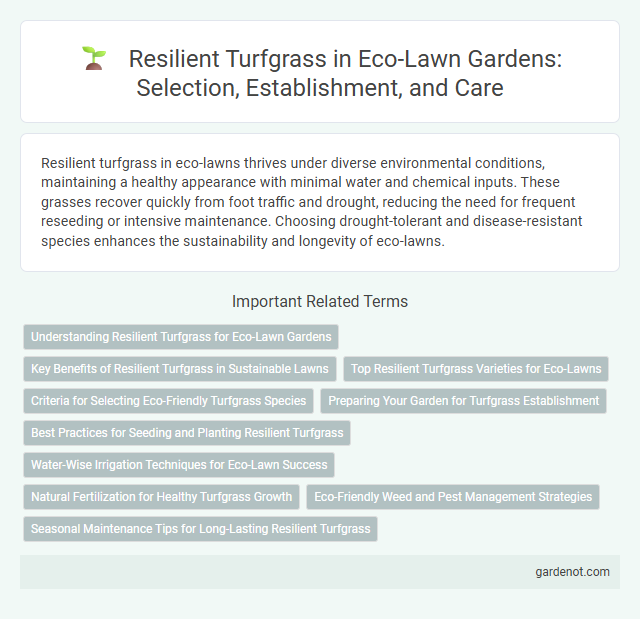Resilient turfgrass in eco-lawns thrives under diverse environmental conditions, maintaining a healthy appearance with minimal water and chemical inputs. These grasses recover quickly from foot traffic and drought, reducing the need for frequent reseeding or intensive maintenance. Choosing drought-tolerant and disease-resistant species enhances the sustainability and longevity of eco-lawns.
Understanding Resilient Turfgrass for Eco-Lawn Gardens
Resilient turfgrass species, such as Kentucky bluegrass and fine fescue, are essential for eco-lawn gardens due to their drought tolerance and low nutrient requirements. These grasses establish deep root systems that enhance soil health and reduce water runoff, supporting sustainable landscaping practices. Understanding the growth cycles and environmental adaptability of resilient turfgrass enables efficient maintenance with minimal chemical inputs, promoting long-term ecological balance.
Key Benefits of Resilient Turfgrass in Sustainable Lawns
Resilient turfgrass enhances sustainable lawns by improving drought tolerance and reducing the need for frequent watering, which conserves water resources. Its deep root systems increase soil stability and prevent erosion, contributing to long-term landscape durability. Additionally, resilient turfgrass promotes biodiversity by supporting beneficial soil microorganisms and reducing reliance on chemical fertilizers and pesticides.
Top Resilient Turfgrass Varieties for Eco-Lawns
Top resilient turfgrass varieties for eco-lawns include Kentucky Bluegrass, Fine Fescue, and Buffalo Grass, known for their drought tolerance and low maintenance needs. Kentucky Bluegrass offers strong recovery and dense growth, while Fine Fescue excels in shade tolerance and nutrient-poor soils. Buffalo Grass thrives in hot, dry climates, requiring minimal watering and mowing, making it ideal for sustainable, eco-friendly lawns.
Criteria for Selecting Eco-Friendly Turfgrass Species
Resilient turfgrass species suitable for eco-lawns exhibit drought tolerance, minimal fertilizer and pesticide requirements, and adaptability to local soil and climate conditions. Selecting native or regionally adapted species such as fine fescues, buffalo grass, or Bermuda grass ensures sustainability and reduced environmental impact. Emphasizing deep root systems and disease resistance supports soil health and long-term turf resilience.
Preparing Your Garden for Turfgrass Establishment
Preparing your garden for resilient turfgrass establishment involves thorough soil aeration and the application of organic compost to enhance nutrient availability. Ensuring proper pH balance, ideally between 6.0 and 7.0, promotes optimal root development and turfgrass health. Consistent watering schedules during the initial growth phase improve seed germination rates and establish a robust, eco-friendly lawn.
Best Practices for Seeding and Planting Resilient Turfgrass
Selecting drought-tolerant turfgrass species such as tall fescue and Kentucky bluegrass enhances lawn resilience. Optimal seeding practices include using high-quality seed with proper soil preparation, ensuring consistent moisture, and applying seed at recommended rates to promote uniform germination. Incorporating overseeding and aeration techniques during planting supports robust root development and turf density, improving resistance to environmental stressors.
Water-Wise Irrigation Techniques for Eco-Lawn Success
Resilient turfgrass in eco-lawns thrives with water-wise irrigation techniques such as deep, infrequent watering to encourage strong root systems and drought tolerance. Utilizing smart irrigation controllers that adjust watering schedules based on weather conditions significantly reduces water waste. Selecting drought-resistant grass varieties further enhances eco-lawn sustainability by minimizing water requirements and promoting long-term lawn health.
Natural Fertilization for Healthy Turfgrass Growth
Resilient turfgrass thrives with natural fertilization methods that enhance soil health and nutrient availability. Organic amendments like compost and manure improve microbial activity, promoting robust root development and disease resistance. Maintaining balanced soil nutrients through eco-friendly practices ensures sustainable, healthy turfgrass growth while minimizing chemical inputs.
Eco-Friendly Weed and Pest Management Strategies
Resilient turfgrass in eco-lawns thrives through sustainable weed and pest management strategies that minimize chemical inputs, utilizing biological controls and organic mulches to enhance soil health and natural pest resistance. Implementing drought-tolerant grass species like fine fescues reduces water usage while supporting ecosystem balance by encouraging beneficial insects that suppress pests. Integrated approaches combining mechanical weeding, native pollinator habitats, and selective natural herbicides create a robust turf environment aligned with environmental conservation goals.
Seasonal Maintenance Tips for Long-Lasting Resilient Turfgrass
Seasonal maintenance is crucial for long-lasting resilient turfgrass, with spring aeration enhancing root oxygenation and fall overseeding promoting thick, healthy growth. Proper mowing height adjustments during summer reduce stress and improve drought tolerance, while winterizing with fertilizer rich in potassium strengthens turfgrass cell walls against cold damage. Regular soil testing and targeted nutrient management optimize turfgrass resilience by addressing specific deficiencies throughout the year.
Resilient turfgrass Infographic

 gardenot.com
gardenot.com